Study Skills and Research Methods (Civil Engineering) Report 2020
VerifiedAdded on 2022/08/20
|12
|3826
|15
Report
AI Summary
This report, prepared for a civil engineering course, focuses on study skills and research methods applied to the issue of construction and demolition waste management. The report investigates the potential of recycling such waste into construction applications, exploring current recycling trends, materials used, and associated advantages and disadvantages. The research includes a literature review of existing studies, the formulation of hypotheses, and the outlining of a methodology that combines both primary and secondary research, including surveys and literature analysis. Ethical considerations are addressed, ensuring confidentiality and proper source acknowledgment. The report also identifies potential risks in the chosen methodology and concludes with the importance of effective waste management in the construction industry, and the potential benefits of recycling construction waste.
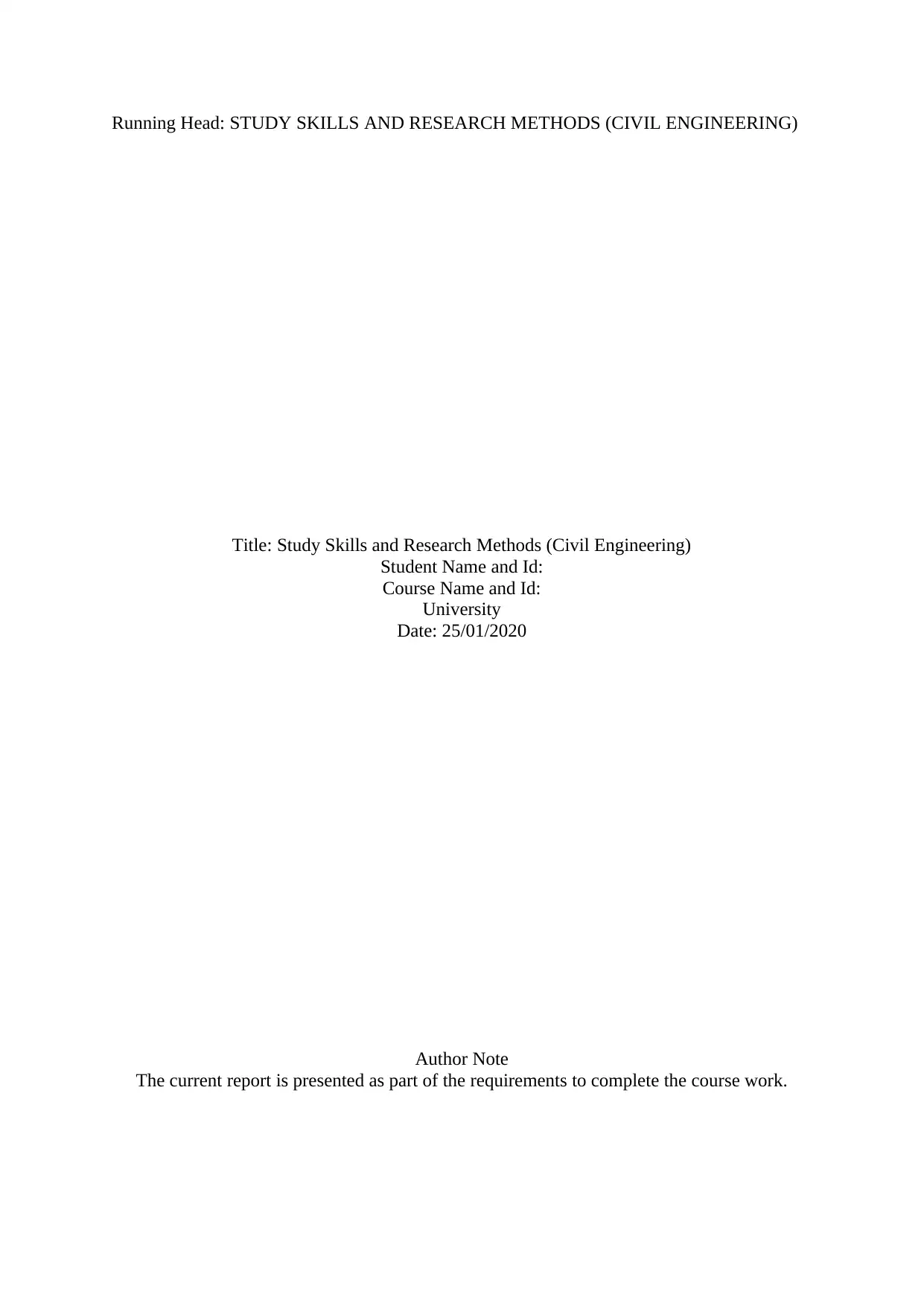
Running Head: STUDY SKILLS AND RESEARCH METHODS (CIVIL ENGINEERING)
Title: Study Skills and Research Methods (Civil Engineering)
Student Name and Id:
Course Name and Id:
University
Date: 25/01/2020
Author Note
The current report is presented as part of the requirements to complete the course work.
Title: Study Skills and Research Methods (Civil Engineering)
Student Name and Id:
Course Name and Id:
University
Date: 25/01/2020
Author Note
The current report is presented as part of the requirements to complete the course work.
Paraphrase This Document
Need a fresh take? Get an instant paraphrase of this document with our AI Paraphraser
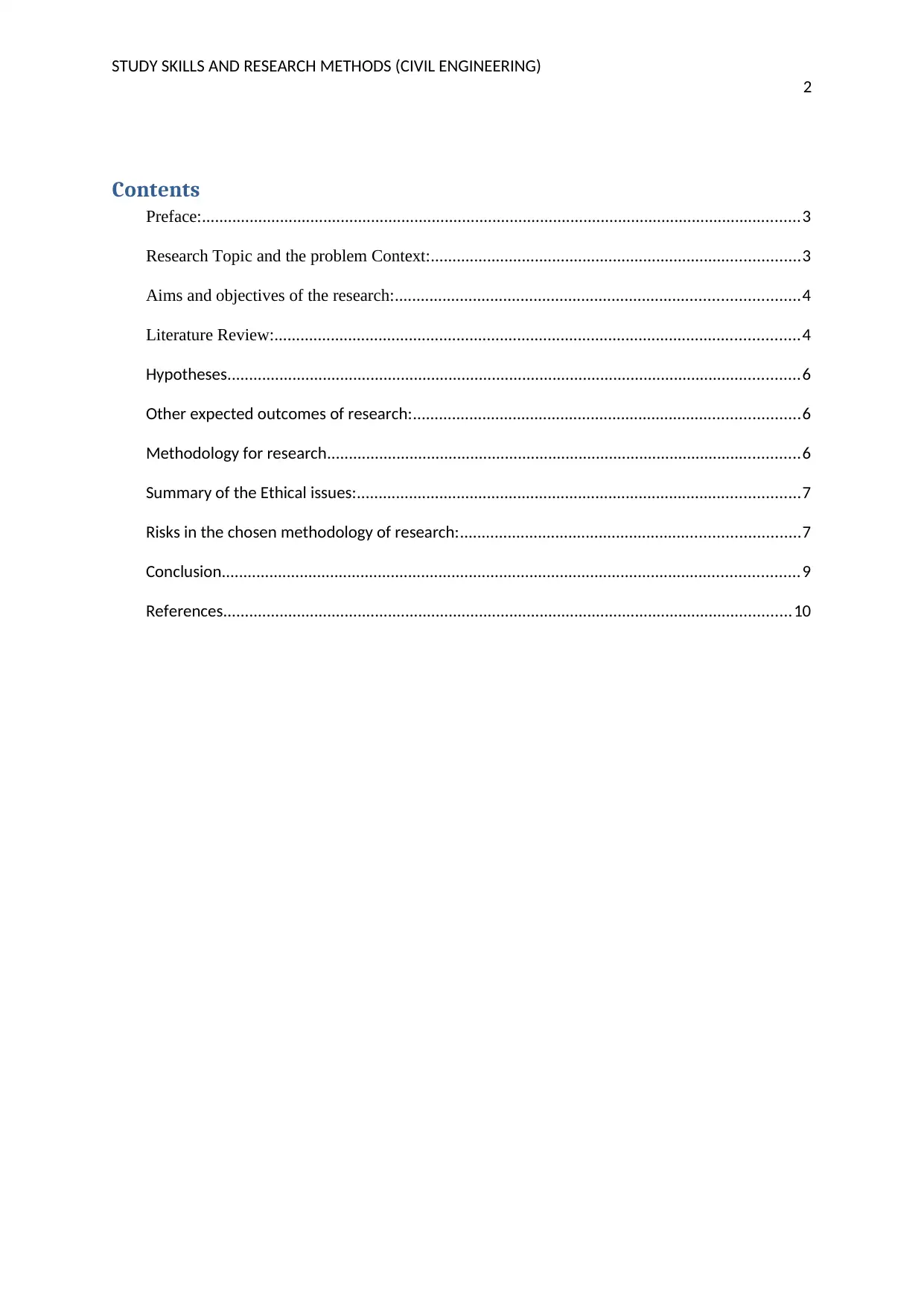
STUDY SKILLS AND RESEARCH METHODS (CIVIL ENGINEERING)
2
Contents
Preface:..........................................................................................................................................3
Research Topic and the problem Context:.....................................................................................3
Aims and objectives of the research:.............................................................................................4
Literature Review:.........................................................................................................................4
Hypotheses....................................................................................................................................6
Other expected outcomes of research:.........................................................................................6
Methodology for research.............................................................................................................6
Summary of the Ethical issues:......................................................................................................7
Risks in the chosen methodology of research:..............................................................................7
Conclusion.....................................................................................................................................9
References...................................................................................................................................10
2
Contents
Preface:..........................................................................................................................................3
Research Topic and the problem Context:.....................................................................................3
Aims and objectives of the research:.............................................................................................4
Literature Review:.........................................................................................................................4
Hypotheses....................................................................................................................................6
Other expected outcomes of research:.........................................................................................6
Methodology for research.............................................................................................................6
Summary of the Ethical issues:......................................................................................................7
Risks in the chosen methodology of research:..............................................................................7
Conclusion.....................................................................................................................................9
References...................................................................................................................................10
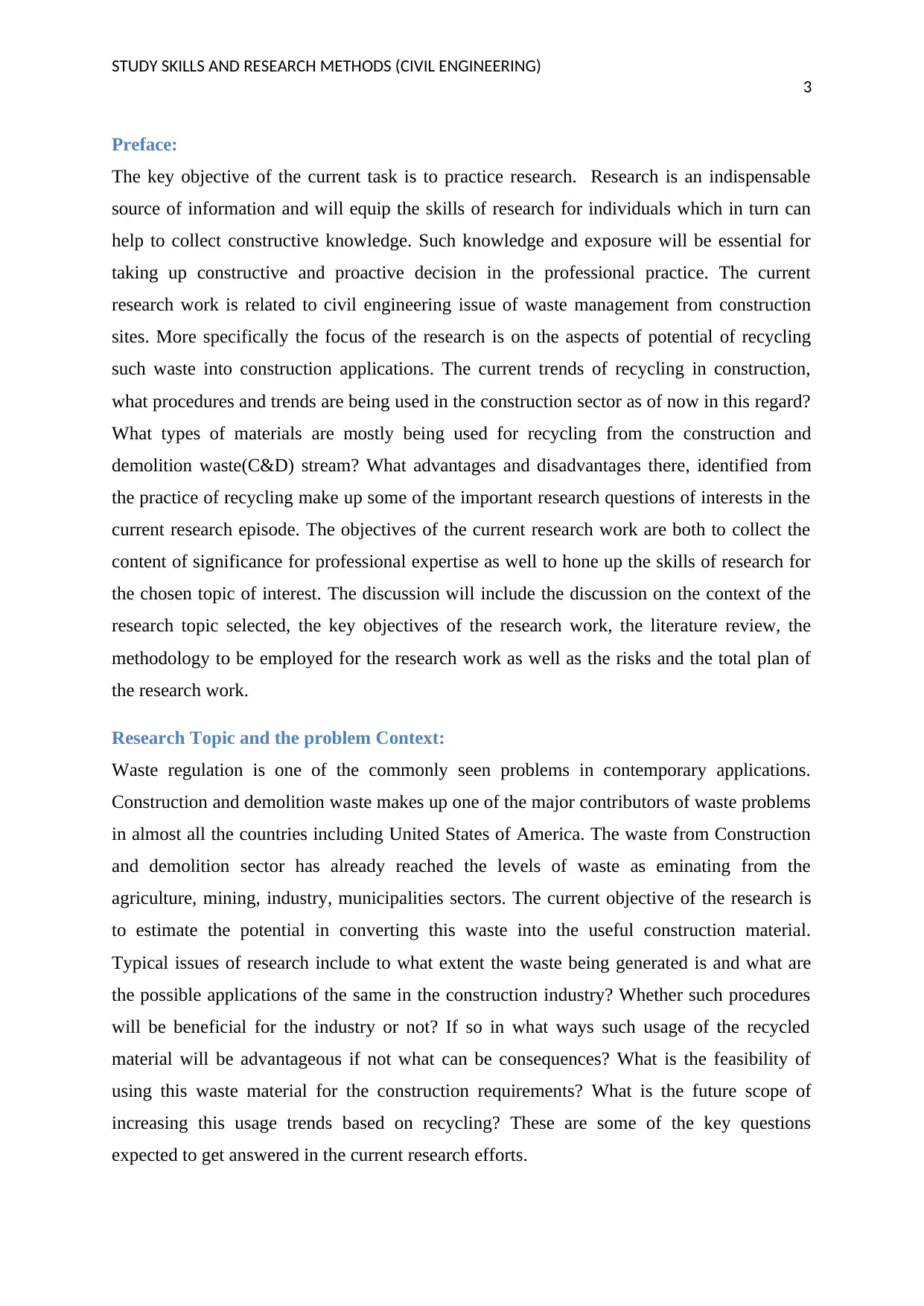
STUDY SKILLS AND RESEARCH METHODS (CIVIL ENGINEERING)
3
Preface:
The key objective of the current task is to practice research. Research is an indispensable
source of information and will equip the skills of research for individuals which in turn can
help to collect constructive knowledge. Such knowledge and exposure will be essential for
taking up constructive and proactive decision in the professional practice. The current
research work is related to civil engineering issue of waste management from construction
sites. More specifically the focus of the research is on the aspects of potential of recycling
such waste into construction applications. The current trends of recycling in construction,
what procedures and trends are being used in the construction sector as of now in this regard?
What types of materials are mostly being used for recycling from the construction and
demolition waste(C&D) stream? What advantages and disadvantages there, identified from
the practice of recycling make up some of the important research questions of interests in the
current research episode. The objectives of the current research work are both to collect the
content of significance for professional expertise as well to hone up the skills of research for
the chosen topic of interest. The discussion will include the discussion on the context of the
research topic selected, the key objectives of the research work, the literature review, the
methodology to be employed for the research work as well as the risks and the total plan of
the research work.
Research Topic and the problem Context:
Waste regulation is one of the commonly seen problems in contemporary applications.
Construction and demolition waste makes up one of the major contributors of waste problems
in almost all the countries including United States of America. The waste from Construction
and demolition sector has already reached the levels of waste as eminating from the
agriculture, mining, industry, municipalities sectors. The current objective of the research is
to estimate the potential in converting this waste into the useful construction material.
Typical issues of research include to what extent the waste being generated is and what are
the possible applications of the same in the construction industry? Whether such procedures
will be beneficial for the industry or not? If so in what ways such usage of the recycled
material will be advantageous if not what can be consequences? What is the feasibility of
using this waste material for the construction requirements? What is the future scope of
increasing this usage trends based on recycling? These are some of the key questions
expected to get answered in the current research efforts.
3
Preface:
The key objective of the current task is to practice research. Research is an indispensable
source of information and will equip the skills of research for individuals which in turn can
help to collect constructive knowledge. Such knowledge and exposure will be essential for
taking up constructive and proactive decision in the professional practice. The current
research work is related to civil engineering issue of waste management from construction
sites. More specifically the focus of the research is on the aspects of potential of recycling
such waste into construction applications. The current trends of recycling in construction,
what procedures and trends are being used in the construction sector as of now in this regard?
What types of materials are mostly being used for recycling from the construction and
demolition waste(C&D) stream? What advantages and disadvantages there, identified from
the practice of recycling make up some of the important research questions of interests in the
current research episode. The objectives of the current research work are both to collect the
content of significance for professional expertise as well to hone up the skills of research for
the chosen topic of interest. The discussion will include the discussion on the context of the
research topic selected, the key objectives of the research work, the literature review, the
methodology to be employed for the research work as well as the risks and the total plan of
the research work.
Research Topic and the problem Context:
Waste regulation is one of the commonly seen problems in contemporary applications.
Construction and demolition waste makes up one of the major contributors of waste problems
in almost all the countries including United States of America. The waste from Construction
and demolition sector has already reached the levels of waste as eminating from the
agriculture, mining, industry, municipalities sectors. The current objective of the research is
to estimate the potential in converting this waste into the useful construction material.
Typical issues of research include to what extent the waste being generated is and what are
the possible applications of the same in the construction industry? Whether such procedures
will be beneficial for the industry or not? If so in what ways such usage of the recycled
material will be advantageous if not what can be consequences? What is the feasibility of
using this waste material for the construction requirements? What is the future scope of
increasing this usage trends based on recycling? These are some of the key questions
expected to get answered in the current research efforts.
⊘ This is a preview!⊘
Do you want full access?
Subscribe today to unlock all pages.

Trusted by 1+ million students worldwide
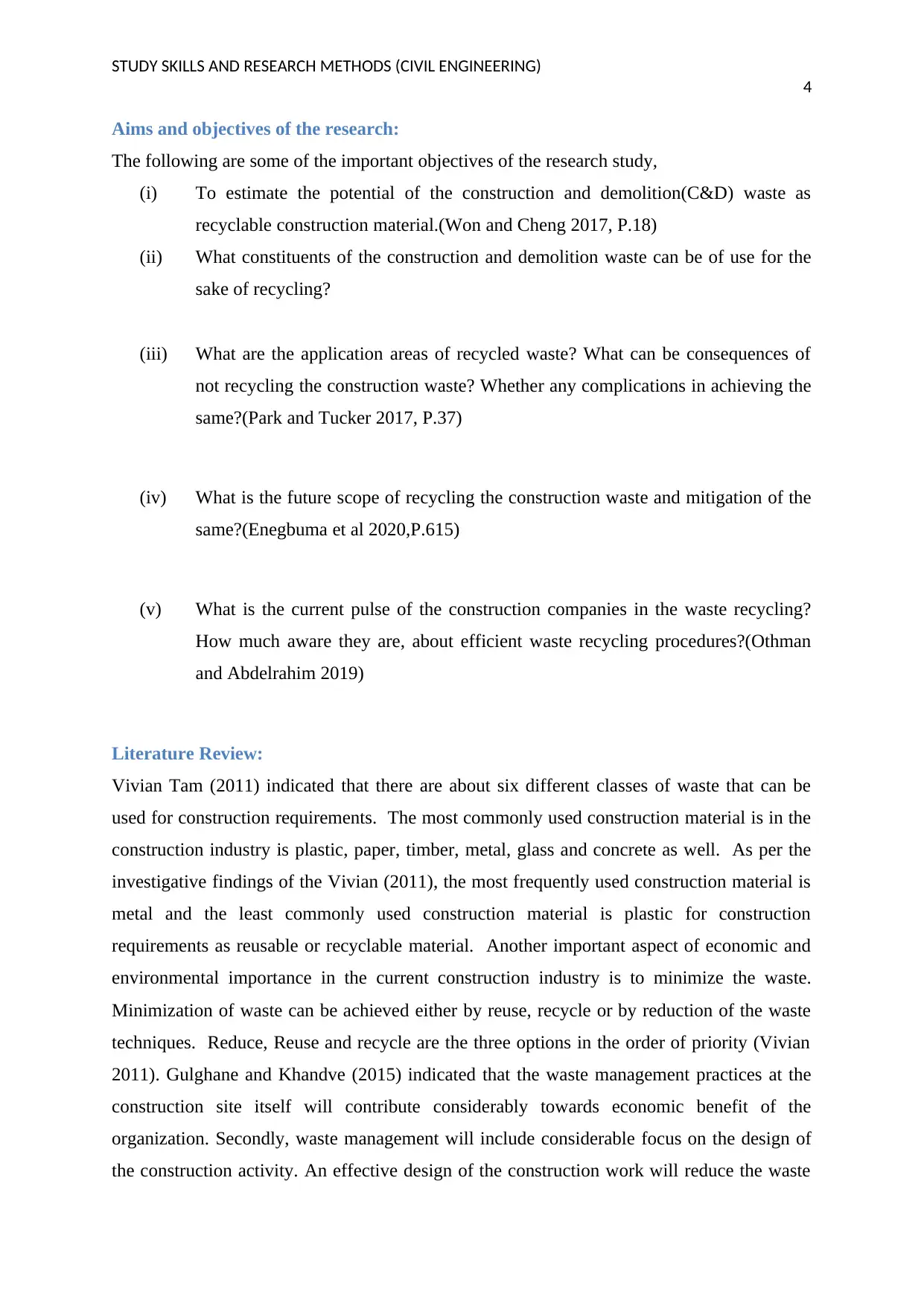
STUDY SKILLS AND RESEARCH METHODS (CIVIL ENGINEERING)
4
Aims and objectives of the research:
The following are some of the important objectives of the research study,
(i) To estimate the potential of the construction and demolition(C&D) waste as
recyclable construction material.(Won and Cheng 2017, P.18)
(ii) What constituents of the construction and demolition waste can be of use for the
sake of recycling?
(iii) What are the application areas of recycled waste? What can be consequences of
not recycling the construction waste? Whether any complications in achieving the
same?(Park and Tucker 2017, P.37)
(iv) What is the future scope of recycling the construction waste and mitigation of the
same?(Enegbuma et al 2020,P.615)
(v) What is the current pulse of the construction companies in the waste recycling?
How much aware they are, about efficient waste recycling procedures?(Othman
and Abdelrahim 2019)
Literature Review:
Vivian Tam (2011) indicated that there are about six different classes of waste that can be
used for construction requirements. The most commonly used construction material is in the
construction industry is plastic, paper, timber, metal, glass and concrete as well. As per the
investigative findings of the Vivian (2011), the most frequently used construction material is
metal and the least commonly used construction material is plastic for construction
requirements as reusable or recyclable material. Another important aspect of economic and
environmental importance in the current construction industry is to minimize the waste.
Minimization of waste can be achieved either by reuse, recycle or by reduction of the waste
techniques. Reduce, Reuse and recycle are the three options in the order of priority (Vivian
2011). Gulghane and Khandve (2015) indicated that the waste management practices at the
construction site itself will contribute considerably towards economic benefit of the
organization. Secondly, waste management will include considerable focus on the design of
the construction activity. An effective design of the construction work will reduce the waste
4
Aims and objectives of the research:
The following are some of the important objectives of the research study,
(i) To estimate the potential of the construction and demolition(C&D) waste as
recyclable construction material.(Won and Cheng 2017, P.18)
(ii) What constituents of the construction and demolition waste can be of use for the
sake of recycling?
(iii) What are the application areas of recycled waste? What can be consequences of
not recycling the construction waste? Whether any complications in achieving the
same?(Park and Tucker 2017, P.37)
(iv) What is the future scope of recycling the construction waste and mitigation of the
same?(Enegbuma et al 2020,P.615)
(v) What is the current pulse of the construction companies in the waste recycling?
How much aware they are, about efficient waste recycling procedures?(Othman
and Abdelrahim 2019)
Literature Review:
Vivian Tam (2011) indicated that there are about six different classes of waste that can be
used for construction requirements. The most commonly used construction material is in the
construction industry is plastic, paper, timber, metal, glass and concrete as well. As per the
investigative findings of the Vivian (2011), the most frequently used construction material is
metal and the least commonly used construction material is plastic for construction
requirements as reusable or recyclable material. Another important aspect of economic and
environmental importance in the current construction industry is to minimize the waste.
Minimization of waste can be achieved either by reuse, recycle or by reduction of the waste
techniques. Reduce, Reuse and recycle are the three options in the order of priority (Vivian
2011). Gulghane and Khandve (2015) indicated that the waste management practices at the
construction site itself will contribute considerably towards economic benefit of the
organization. Secondly, waste management will include considerable focus on the design of
the construction activity. An effective design of the construction work will reduce the waste
Paraphrase This Document
Need a fresh take? Get an instant paraphrase of this document with our AI Paraphraser
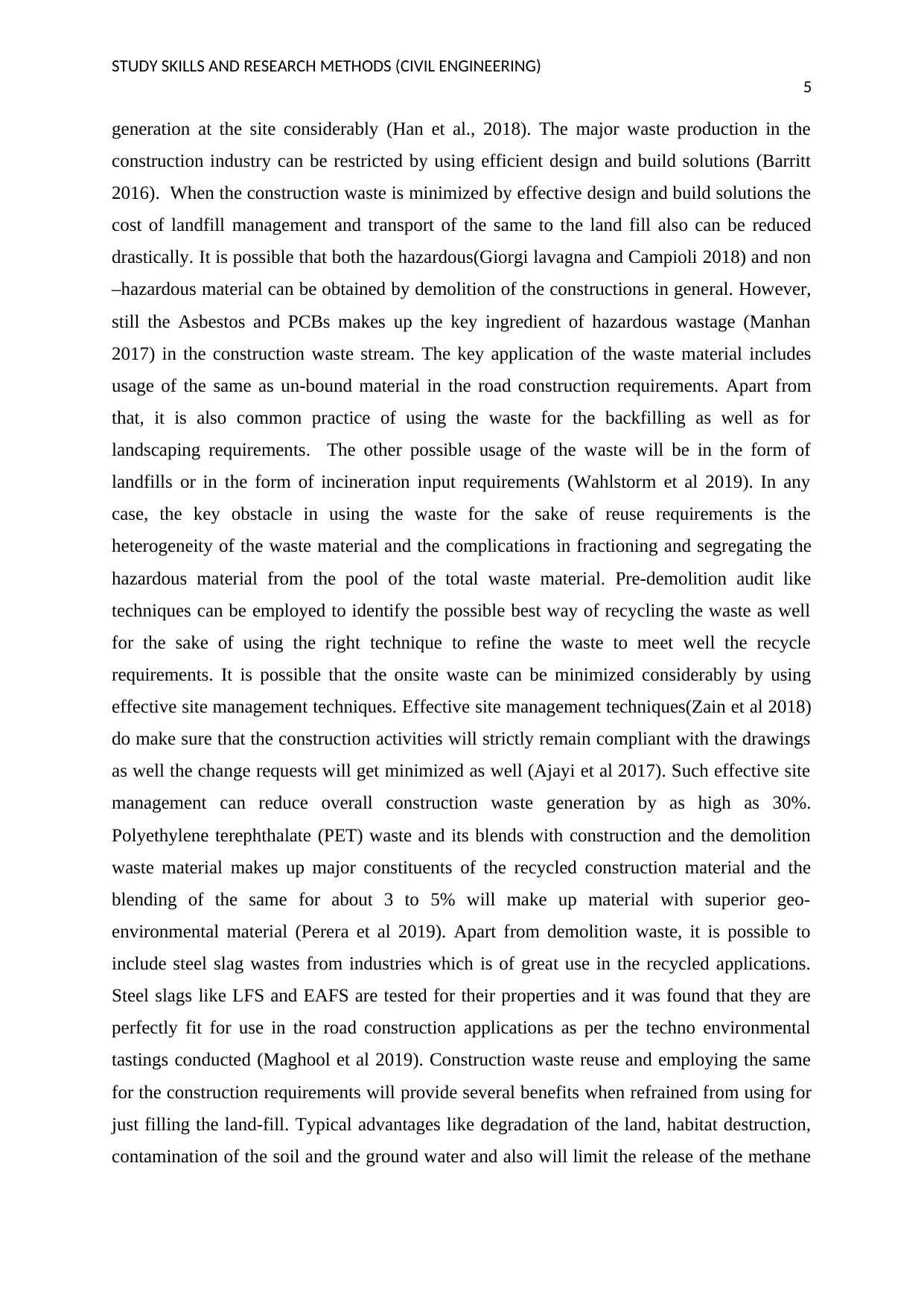
STUDY SKILLS AND RESEARCH METHODS (CIVIL ENGINEERING)
5
generation at the site considerably (Han et al., 2018). The major waste production in the
construction industry can be restricted by using efficient design and build solutions (Barritt
2016). When the construction waste is minimized by effective design and build solutions the
cost of landfill management and transport of the same to the land fill also can be reduced
drastically. It is possible that both the hazardous(Giorgi lavagna and Campioli 2018) and non
–hazardous material can be obtained by demolition of the constructions in general. However,
still the Asbestos and PCBs makes up the key ingredient of hazardous wastage (Manhan
2017) in the construction waste stream. The key application of the waste material includes
usage of the same as un-bound material in the road construction requirements. Apart from
that, it is also common practice of using the waste for the backfilling as well as for
landscaping requirements. The other possible usage of the waste will be in the form of
landfills or in the form of incineration input requirements (Wahlstorm et al 2019). In any
case, the key obstacle in using the waste for the sake of reuse requirements is the
heterogeneity of the waste material and the complications in fractioning and segregating the
hazardous material from the pool of the total waste material. Pre-demolition audit like
techniques can be employed to identify the possible best way of recycling the waste as well
for the sake of using the right technique to refine the waste to meet well the recycle
requirements. It is possible that the onsite waste can be minimized considerably by using
effective site management techniques. Effective site management techniques(Zain et al 2018)
do make sure that the construction activities will strictly remain compliant with the drawings
as well the change requests will get minimized as well (Ajayi et al 2017). Such effective site
management can reduce overall construction waste generation by as high as 30%.
Polyethylene terephthalate (PET) waste and its blends with construction and the demolition
waste material makes up major constituents of the recycled construction material and the
blending of the same for about 3 to 5% will make up material with superior geo-
environmental material (Perera et al 2019). Apart from demolition waste, it is possible to
include steel slag wastes from industries which is of great use in the recycled applications.
Steel slags like LFS and EAFS are tested for their properties and it was found that they are
perfectly fit for use in the road construction applications as per the techno environmental
tastings conducted (Maghool et al 2019). Construction waste reuse and employing the same
for the construction requirements will provide several benefits when refrained from using for
just filling the land-fill. Typical advantages like degradation of the land, habitat destruction,
contamination of the soil and the ground water and also will limit the release of the methane
5
generation at the site considerably (Han et al., 2018). The major waste production in the
construction industry can be restricted by using efficient design and build solutions (Barritt
2016). When the construction waste is minimized by effective design and build solutions the
cost of landfill management and transport of the same to the land fill also can be reduced
drastically. It is possible that both the hazardous(Giorgi lavagna and Campioli 2018) and non
–hazardous material can be obtained by demolition of the constructions in general. However,
still the Asbestos and PCBs makes up the key ingredient of hazardous wastage (Manhan
2017) in the construction waste stream. The key application of the waste material includes
usage of the same as un-bound material in the road construction requirements. Apart from
that, it is also common practice of using the waste for the backfilling as well as for
landscaping requirements. The other possible usage of the waste will be in the form of
landfills or in the form of incineration input requirements (Wahlstorm et al 2019). In any
case, the key obstacle in using the waste for the sake of reuse requirements is the
heterogeneity of the waste material and the complications in fractioning and segregating the
hazardous material from the pool of the total waste material. Pre-demolition audit like
techniques can be employed to identify the possible best way of recycling the waste as well
for the sake of using the right technique to refine the waste to meet well the recycle
requirements. It is possible that the onsite waste can be minimized considerably by using
effective site management techniques. Effective site management techniques(Zain et al 2018)
do make sure that the construction activities will strictly remain compliant with the drawings
as well the change requests will get minimized as well (Ajayi et al 2017). Such effective site
management can reduce overall construction waste generation by as high as 30%.
Polyethylene terephthalate (PET) waste and its blends with construction and the demolition
waste material makes up major constituents of the recycled construction material and the
blending of the same for about 3 to 5% will make up material with superior geo-
environmental material (Perera et al 2019). Apart from demolition waste, it is possible to
include steel slag wastes from industries which is of great use in the recycled applications.
Steel slags like LFS and EAFS are tested for their properties and it was found that they are
perfectly fit for use in the road construction applications as per the techno environmental
tastings conducted (Maghool et al 2019). Construction waste reuse and employing the same
for the construction requirements will provide several benefits when refrained from using for
just filling the land-fill. Typical advantages like degradation of the land, habitat destruction,
contamination of the soil and the ground water and also will limit the release of the methane
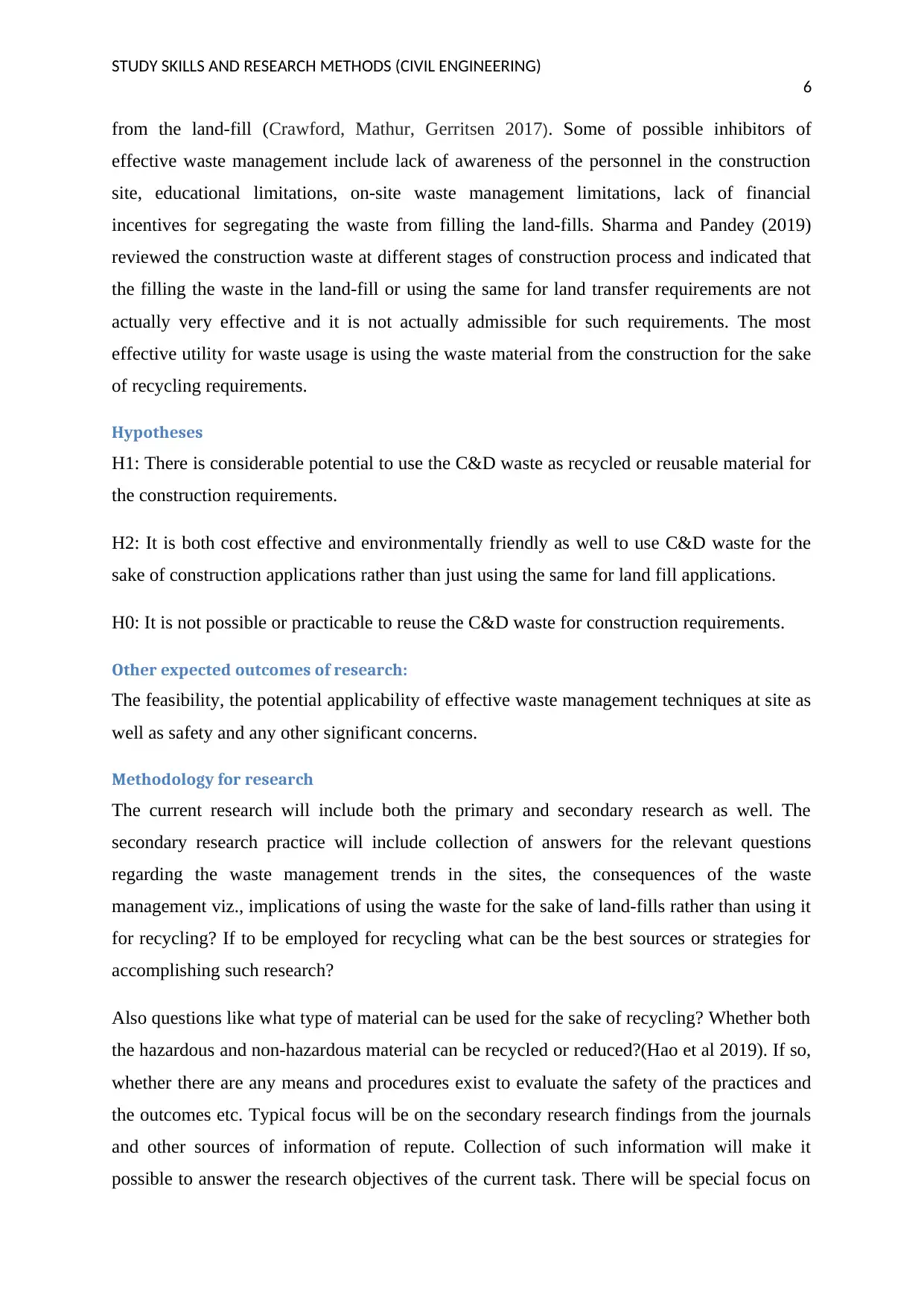
STUDY SKILLS AND RESEARCH METHODS (CIVIL ENGINEERING)
6
from the land-fill (Crawford, Mathur, Gerritsen 2017). Some of possible inhibitors of
effective waste management include lack of awareness of the personnel in the construction
site, educational limitations, on-site waste management limitations, lack of financial
incentives for segregating the waste from filling the land-fills. Sharma and Pandey (2019)
reviewed the construction waste at different stages of construction process and indicated that
the filling the waste in the land-fill or using the same for land transfer requirements are not
actually very effective and it is not actually admissible for such requirements. The most
effective utility for waste usage is using the waste material from the construction for the sake
of recycling requirements.
Hypotheses
H1: There is considerable potential to use the C&D waste as recycled or reusable material for
the construction requirements.
H2: It is both cost effective and environmentally friendly as well to use C&D waste for the
sake of construction applications rather than just using the same for land fill applications.
H0: It is not possible or practicable to reuse the C&D waste for construction requirements.
Other expected outcomes of research:
The feasibility, the potential applicability of effective waste management techniques at site as
well as safety and any other significant concerns.
Methodology for research
The current research will include both the primary and secondary research as well. The
secondary research practice will include collection of answers for the relevant questions
regarding the waste management trends in the sites, the consequences of the waste
management viz., implications of using the waste for the sake of land-fills rather than using it
for recycling? If to be employed for recycling what can be the best sources or strategies for
accomplishing such research?
Also questions like what type of material can be used for the sake of recycling? Whether both
the hazardous and non-hazardous material can be recycled or reduced?(Hao et al 2019). If so,
whether there are any means and procedures exist to evaluate the safety of the practices and
the outcomes etc. Typical focus will be on the secondary research findings from the journals
and other sources of information of repute. Collection of such information will make it
possible to answer the research objectives of the current task. There will be special focus on
6
from the land-fill (Crawford, Mathur, Gerritsen 2017). Some of possible inhibitors of
effective waste management include lack of awareness of the personnel in the construction
site, educational limitations, on-site waste management limitations, lack of financial
incentives for segregating the waste from filling the land-fills. Sharma and Pandey (2019)
reviewed the construction waste at different stages of construction process and indicated that
the filling the waste in the land-fill or using the same for land transfer requirements are not
actually very effective and it is not actually admissible for such requirements. The most
effective utility for waste usage is using the waste material from the construction for the sake
of recycling requirements.
Hypotheses
H1: There is considerable potential to use the C&D waste as recycled or reusable material for
the construction requirements.
H2: It is both cost effective and environmentally friendly as well to use C&D waste for the
sake of construction applications rather than just using the same for land fill applications.
H0: It is not possible or practicable to reuse the C&D waste for construction requirements.
Other expected outcomes of research:
The feasibility, the potential applicability of effective waste management techniques at site as
well as safety and any other significant concerns.
Methodology for research
The current research will include both the primary and secondary research as well. The
secondary research practice will include collection of answers for the relevant questions
regarding the waste management trends in the sites, the consequences of the waste
management viz., implications of using the waste for the sake of land-fills rather than using it
for recycling? If to be employed for recycling what can be the best sources or strategies for
accomplishing such research?
Also questions like what type of material can be used for the sake of recycling? Whether both
the hazardous and non-hazardous material can be recycled or reduced?(Hao et al 2019). If so,
whether there are any means and procedures exist to evaluate the safety of the practices and
the outcomes etc. Typical focus will be on the secondary research findings from the journals
and other sources of information of repute. Collection of such information will make it
possible to answer the research objectives of the current task. There will be special focus on
⊘ This is a preview!⊘
Do you want full access?
Subscribe today to unlock all pages.

Trusted by 1+ million students worldwide
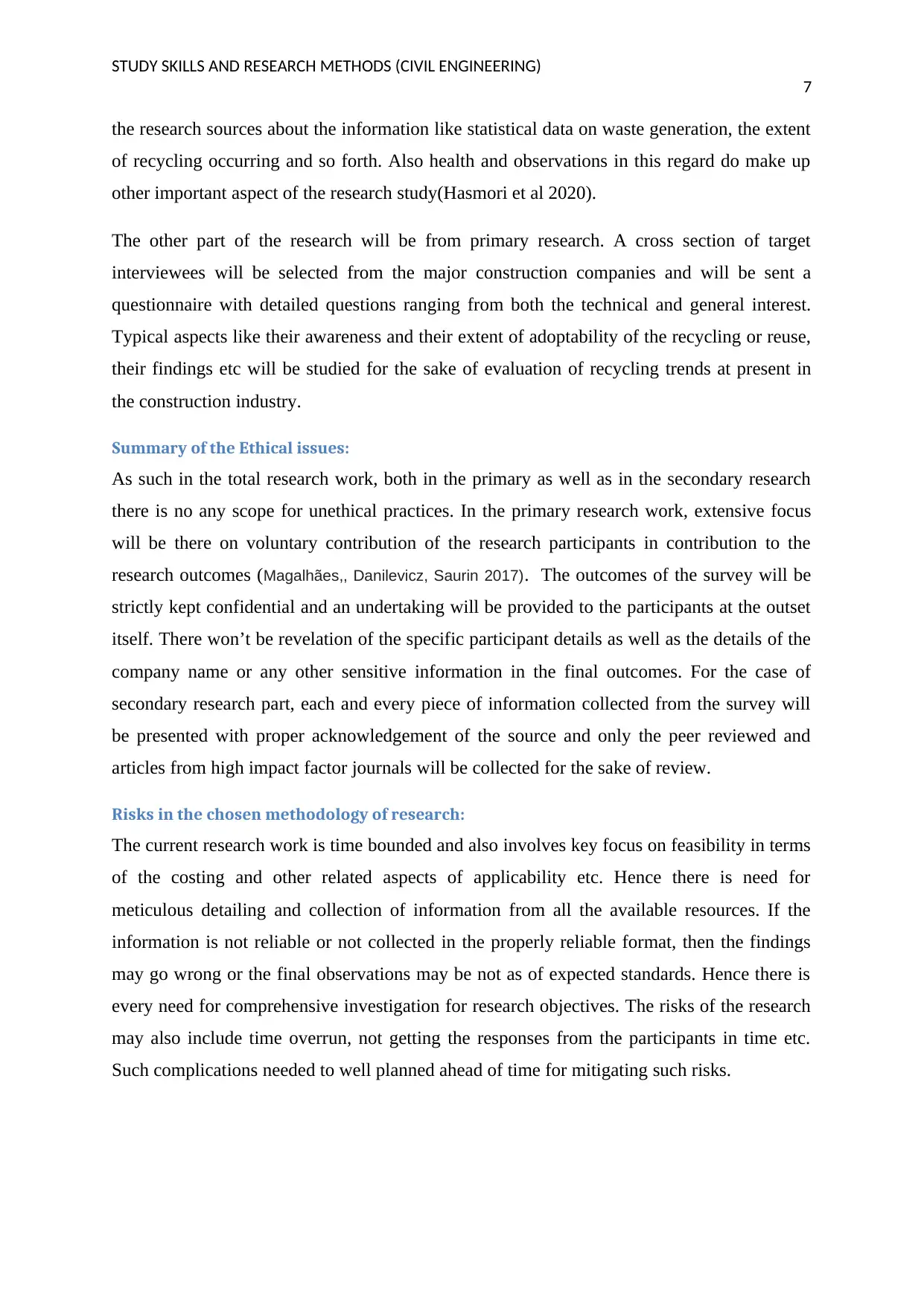
STUDY SKILLS AND RESEARCH METHODS (CIVIL ENGINEERING)
7
the research sources about the information like statistical data on waste generation, the extent
of recycling occurring and so forth. Also health and observations in this regard do make up
other important aspect of the research study(Hasmori et al 2020).
The other part of the research will be from primary research. A cross section of target
interviewees will be selected from the major construction companies and will be sent a
questionnaire with detailed questions ranging from both the technical and general interest.
Typical aspects like their awareness and their extent of adoptability of the recycling or reuse,
their findings etc will be studied for the sake of evaluation of recycling trends at present in
the construction industry.
Summary of the Ethical issues:
As such in the total research work, both in the primary as well as in the secondary research
there is no any scope for unethical practices. In the primary research work, extensive focus
will be there on voluntary contribution of the research participants in contribution to the
research outcomes (Magalhães,, Danilevicz, Saurin 2017). The outcomes of the survey will be
strictly kept confidential and an undertaking will be provided to the participants at the outset
itself. There won’t be revelation of the specific participant details as well as the details of the
company name or any other sensitive information in the final outcomes. For the case of
secondary research part, each and every piece of information collected from the survey will
be presented with proper acknowledgement of the source and only the peer reviewed and
articles from high impact factor journals will be collected for the sake of review.
Risks in the chosen methodology of research:
The current research work is time bounded and also involves key focus on feasibility in terms
of the costing and other related aspects of applicability etc. Hence there is need for
meticulous detailing and collection of information from all the available resources. If the
information is not reliable or not collected in the properly reliable format, then the findings
may go wrong or the final observations may be not as of expected standards. Hence there is
every need for comprehensive investigation for research objectives. The risks of the research
may also include time overrun, not getting the responses from the participants in time etc.
Such complications needed to well planned ahead of time for mitigating such risks.
7
the research sources about the information like statistical data on waste generation, the extent
of recycling occurring and so forth. Also health and observations in this regard do make up
other important aspect of the research study(Hasmori et al 2020).
The other part of the research will be from primary research. A cross section of target
interviewees will be selected from the major construction companies and will be sent a
questionnaire with detailed questions ranging from both the technical and general interest.
Typical aspects like their awareness and their extent of adoptability of the recycling or reuse,
their findings etc will be studied for the sake of evaluation of recycling trends at present in
the construction industry.
Summary of the Ethical issues:
As such in the total research work, both in the primary as well as in the secondary research
there is no any scope for unethical practices. In the primary research work, extensive focus
will be there on voluntary contribution of the research participants in contribution to the
research outcomes (Magalhães,, Danilevicz, Saurin 2017). The outcomes of the survey will be
strictly kept confidential and an undertaking will be provided to the participants at the outset
itself. There won’t be revelation of the specific participant details as well as the details of the
company name or any other sensitive information in the final outcomes. For the case of
secondary research part, each and every piece of information collected from the survey will
be presented with proper acknowledgement of the source and only the peer reviewed and
articles from high impact factor journals will be collected for the sake of review.
Risks in the chosen methodology of research:
The current research work is time bounded and also involves key focus on feasibility in terms
of the costing and other related aspects of applicability etc. Hence there is need for
meticulous detailing and collection of information from all the available resources. If the
information is not reliable or not collected in the properly reliable format, then the findings
may go wrong or the final observations may be not as of expected standards. Hence there is
every need for comprehensive investigation for research objectives. The risks of the research
may also include time overrun, not getting the responses from the participants in time etc.
Such complications needed to well planned ahead of time for mitigating such risks.
Paraphrase This Document
Need a fresh take? Get an instant paraphrase of this document with our AI Paraphraser
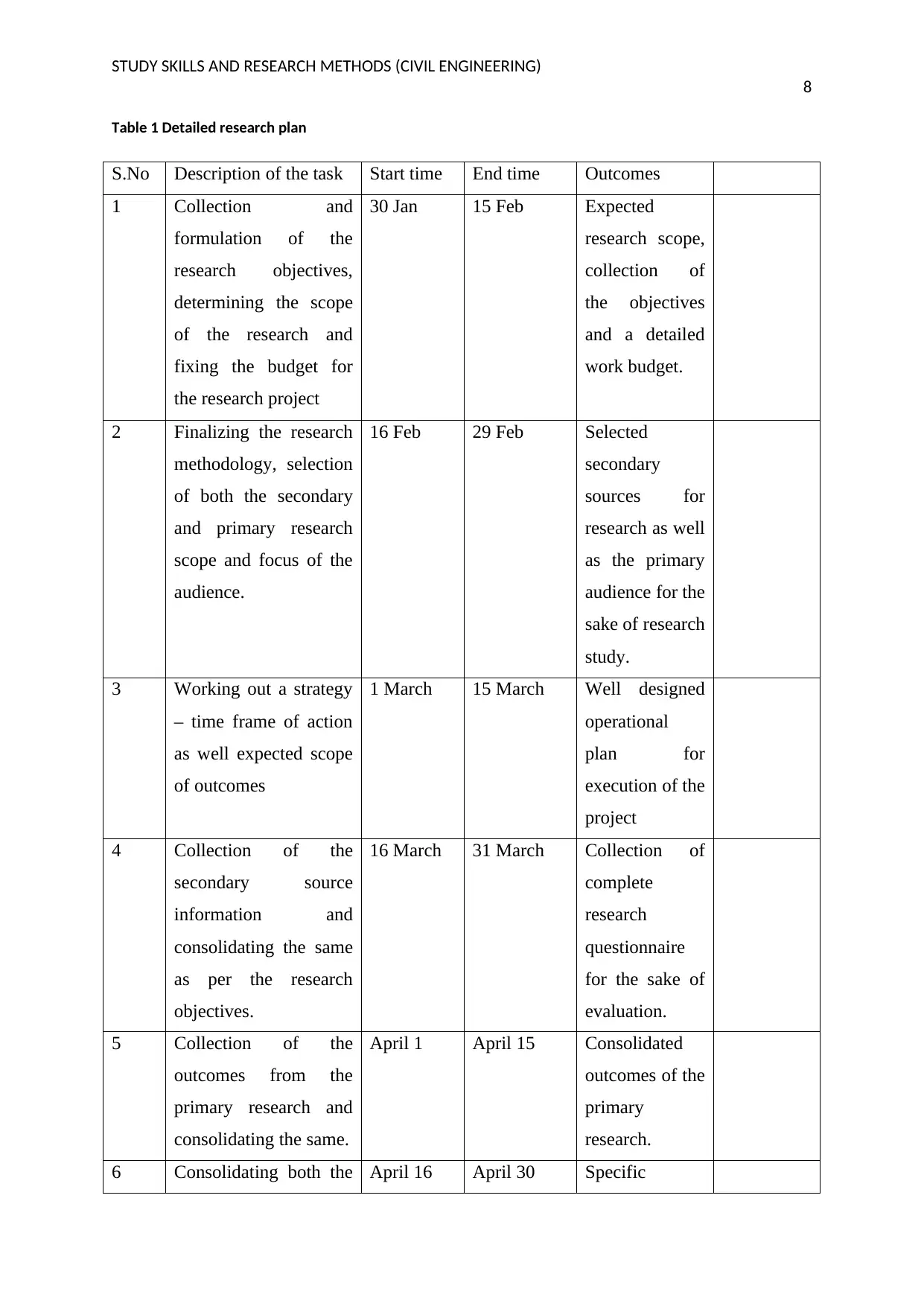
STUDY SKILLS AND RESEARCH METHODS (CIVIL ENGINEERING)
8
Table 1 Detailed research plan
S.No Description of the task Start time End time Outcomes
1 Collection and
formulation of the
research objectives,
determining the scope
of the research and
fixing the budget for
the research project
30 Jan 15 Feb Expected
research scope,
collection of
the objectives
and a detailed
work budget.
2 Finalizing the research
methodology, selection
of both the secondary
and primary research
scope and focus of the
audience.
16 Feb 29 Feb Selected
secondary
sources for
research as well
as the primary
audience for the
sake of research
study.
3 Working out a strategy
– time frame of action
as well expected scope
of outcomes
1 March 15 March Well designed
operational
plan for
execution of the
project
4 Collection of the
secondary source
information and
consolidating the same
as per the research
objectives.
16 March 31 March Collection of
complete
research
questionnaire
for the sake of
evaluation.
5 Collection of the
outcomes from the
primary research and
consolidating the same.
April 1 April 15 Consolidated
outcomes of the
primary
research.
6 Consolidating both the April 16 April 30 Specific
8
Table 1 Detailed research plan
S.No Description of the task Start time End time Outcomes
1 Collection and
formulation of the
research objectives,
determining the scope
of the research and
fixing the budget for
the research project
30 Jan 15 Feb Expected
research scope,
collection of
the objectives
and a detailed
work budget.
2 Finalizing the research
methodology, selection
of both the secondary
and primary research
scope and focus of the
audience.
16 Feb 29 Feb Selected
secondary
sources for
research as well
as the primary
audience for the
sake of research
study.
3 Working out a strategy
– time frame of action
as well expected scope
of outcomes
1 March 15 March Well designed
operational
plan for
execution of the
project
4 Collection of the
secondary source
information and
consolidating the same
as per the research
objectives.
16 March 31 March Collection of
complete
research
questionnaire
for the sake of
evaluation.
5 Collection of the
outcomes from the
primary research and
consolidating the same.
April 1 April 15 Consolidated
outcomes of the
primary
research.
6 Consolidating both the April 16 April 30 Specific
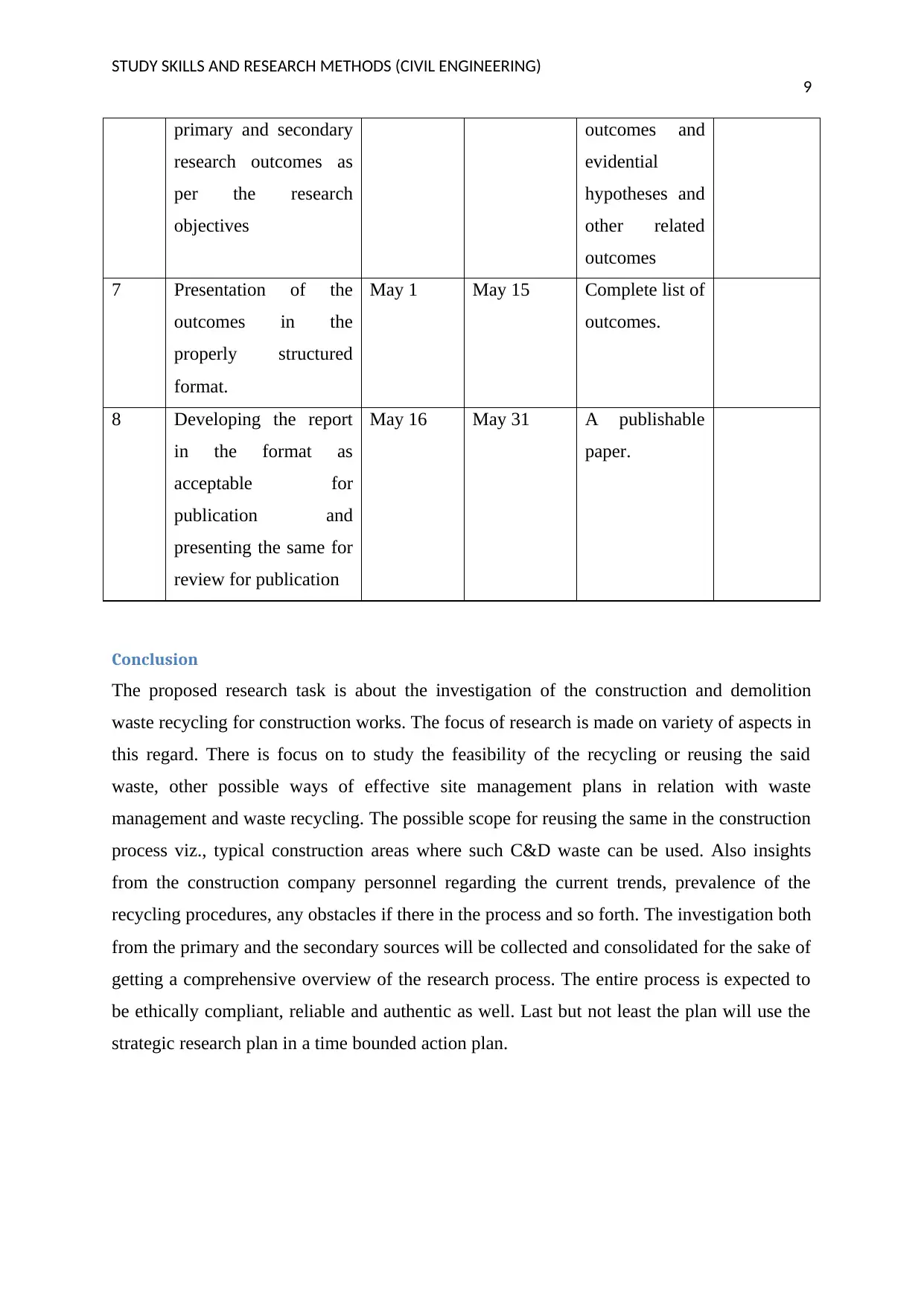
STUDY SKILLS AND RESEARCH METHODS (CIVIL ENGINEERING)
9
primary and secondary
research outcomes as
per the research
objectives
outcomes and
evidential
hypotheses and
other related
outcomes
7 Presentation of the
outcomes in the
properly structured
format.
May 1 May 15 Complete list of
outcomes.
8 Developing the report
in the format as
acceptable for
publication and
presenting the same for
review for publication
May 16 May 31 A publishable
paper.
Conclusion
The proposed research task is about the investigation of the construction and demolition
waste recycling for construction works. The focus of research is made on variety of aspects in
this regard. There is focus on to study the feasibility of the recycling or reusing the said
waste, other possible ways of effective site management plans in relation with waste
management and waste recycling. The possible scope for reusing the same in the construction
process viz., typical construction areas where such C&D waste can be used. Also insights
from the construction company personnel regarding the current trends, prevalence of the
recycling procedures, any obstacles if there in the process and so forth. The investigation both
from the primary and the secondary sources will be collected and consolidated for the sake of
getting a comprehensive overview of the research process. The entire process is expected to
be ethically compliant, reliable and authentic as well. Last but not least the plan will use the
strategic research plan in a time bounded action plan.
9
primary and secondary
research outcomes as
per the research
objectives
outcomes and
evidential
hypotheses and
other related
outcomes
7 Presentation of the
outcomes in the
properly structured
format.
May 1 May 15 Complete list of
outcomes.
8 Developing the report
in the format as
acceptable for
publication and
presenting the same for
review for publication
May 16 May 31 A publishable
paper.
Conclusion
The proposed research task is about the investigation of the construction and demolition
waste recycling for construction works. The focus of research is made on variety of aspects in
this regard. There is focus on to study the feasibility of the recycling or reusing the said
waste, other possible ways of effective site management plans in relation with waste
management and waste recycling. The possible scope for reusing the same in the construction
process viz., typical construction areas where such C&D waste can be used. Also insights
from the construction company personnel regarding the current trends, prevalence of the
recycling procedures, any obstacles if there in the process and so forth. The investigation both
from the primary and the secondary sources will be collected and consolidated for the sake of
getting a comprehensive overview of the research process. The entire process is expected to
be ethically compliant, reliable and authentic as well. Last but not least the plan will use the
strategic research plan in a time bounded action plan.
⊘ This is a preview!⊘
Do you want full access?
Subscribe today to unlock all pages.

Trusted by 1+ million students worldwide
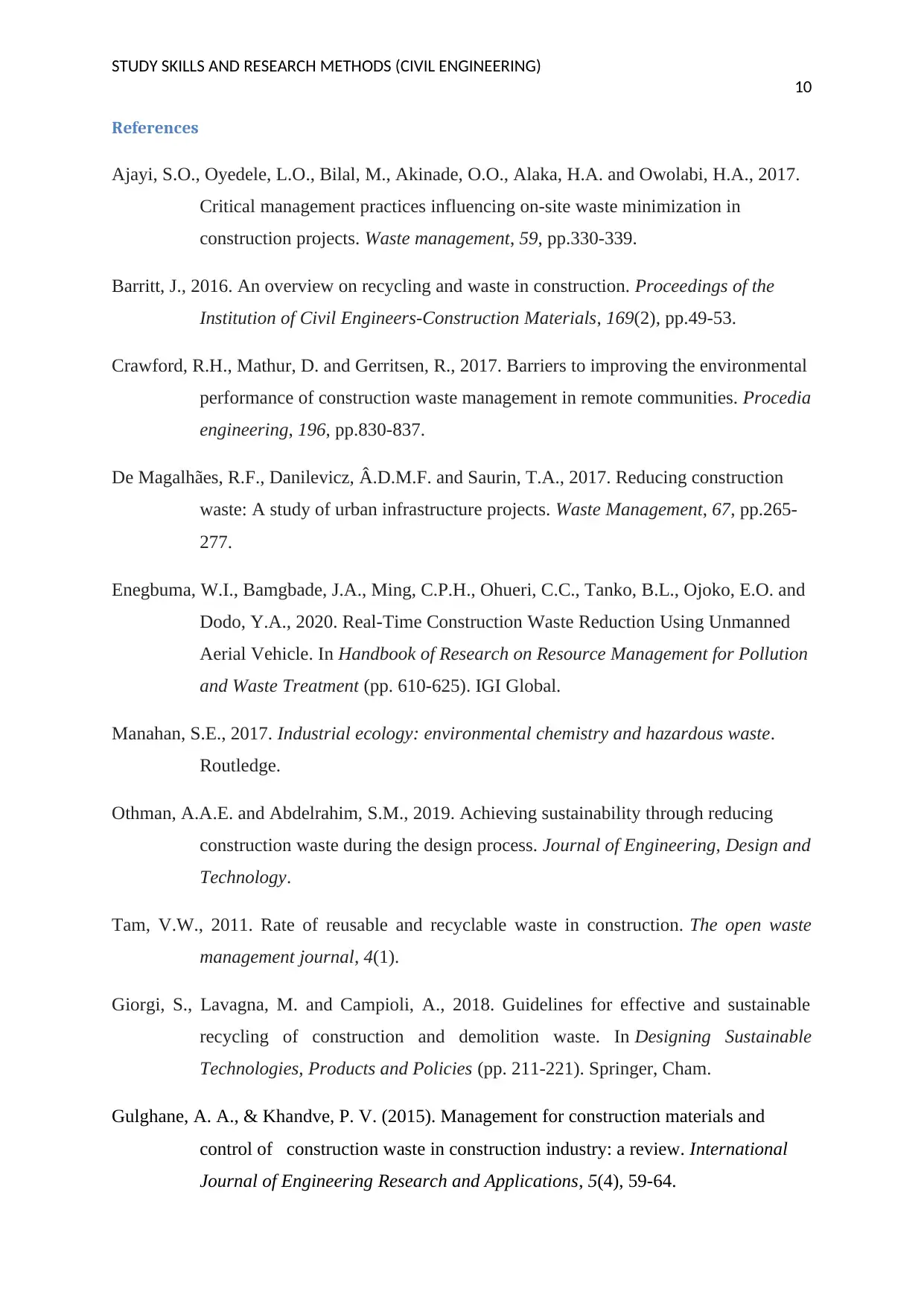
STUDY SKILLS AND RESEARCH METHODS (CIVIL ENGINEERING)
10
References
Ajayi, S.O., Oyedele, L.O., Bilal, M., Akinade, O.O., Alaka, H.A. and Owolabi, H.A., 2017.
Critical management practices influencing on-site waste minimization in
construction projects. Waste management, 59, pp.330-339.
Barritt, J., 2016. An overview on recycling and waste in construction. Proceedings of the
Institution of Civil Engineers-Construction Materials, 169(2), pp.49-53.
Crawford, R.H., Mathur, D. and Gerritsen, R., 2017. Barriers to improving the environmental
performance of construction waste management in remote communities. Procedia
engineering, 196, pp.830-837.
De Magalhães, R.F., Danilevicz, Â.D.M.F. and Saurin, T.A., 2017. Reducing construction
waste: A study of urban infrastructure projects. Waste Management, 67, pp.265-
277.
Enegbuma, W.I., Bamgbade, J.A., Ming, C.P.H., Ohueri, C.C., Tanko, B.L., Ojoko, E.O. and
Dodo, Y.A., 2020. Real-Time Construction Waste Reduction Using Unmanned
Aerial Vehicle. In Handbook of Research on Resource Management for Pollution
and Waste Treatment (pp. 610-625). IGI Global.
Manahan, S.E., 2017. Industrial ecology: environmental chemistry and hazardous waste.
Routledge.
Othman, A.A.E. and Abdelrahim, S.M., 2019. Achieving sustainability through reducing
construction waste during the design process. Journal of Engineering, Design and
Technology.
Tam, V.W., 2011. Rate of reusable and recyclable waste in construction. The open waste
management journal, 4(1).
Giorgi, S., Lavagna, M. and Campioli, A., 2018. Guidelines for effective and sustainable
recycling of construction and demolition waste. In Designing Sustainable
Technologies, Products and Policies (pp. 211-221). Springer, Cham.
Gulghane, A. A., & Khandve, P. V. (2015). Management for construction materials and
control of construction waste in construction industry: a review. International
Journal of Engineering Research and Applications, 5(4), 59-64.
10
References
Ajayi, S.O., Oyedele, L.O., Bilal, M., Akinade, O.O., Alaka, H.A. and Owolabi, H.A., 2017.
Critical management practices influencing on-site waste minimization in
construction projects. Waste management, 59, pp.330-339.
Barritt, J., 2016. An overview on recycling and waste in construction. Proceedings of the
Institution of Civil Engineers-Construction Materials, 169(2), pp.49-53.
Crawford, R.H., Mathur, D. and Gerritsen, R., 2017. Barriers to improving the environmental
performance of construction waste management in remote communities. Procedia
engineering, 196, pp.830-837.
De Magalhães, R.F., Danilevicz, Â.D.M.F. and Saurin, T.A., 2017. Reducing construction
waste: A study of urban infrastructure projects. Waste Management, 67, pp.265-
277.
Enegbuma, W.I., Bamgbade, J.A., Ming, C.P.H., Ohueri, C.C., Tanko, B.L., Ojoko, E.O. and
Dodo, Y.A., 2020. Real-Time Construction Waste Reduction Using Unmanned
Aerial Vehicle. In Handbook of Research on Resource Management for Pollution
and Waste Treatment (pp. 610-625). IGI Global.
Manahan, S.E., 2017. Industrial ecology: environmental chemistry and hazardous waste.
Routledge.
Othman, A.A.E. and Abdelrahim, S.M., 2019. Achieving sustainability through reducing
construction waste during the design process. Journal of Engineering, Design and
Technology.
Tam, V.W., 2011. Rate of reusable and recyclable waste in construction. The open waste
management journal, 4(1).
Giorgi, S., Lavagna, M. and Campioli, A., 2018. Guidelines for effective and sustainable
recycling of construction and demolition waste. In Designing Sustainable
Technologies, Products and Policies (pp. 211-221). Springer, Cham.
Gulghane, A. A., & Khandve, P. V. (2015). Management for construction materials and
control of construction waste in construction industry: a review. International
Journal of Engineering Research and Applications, 5(4), 59-64.
Paraphrase This Document
Need a fresh take? Get an instant paraphrase of this document with our AI Paraphraser
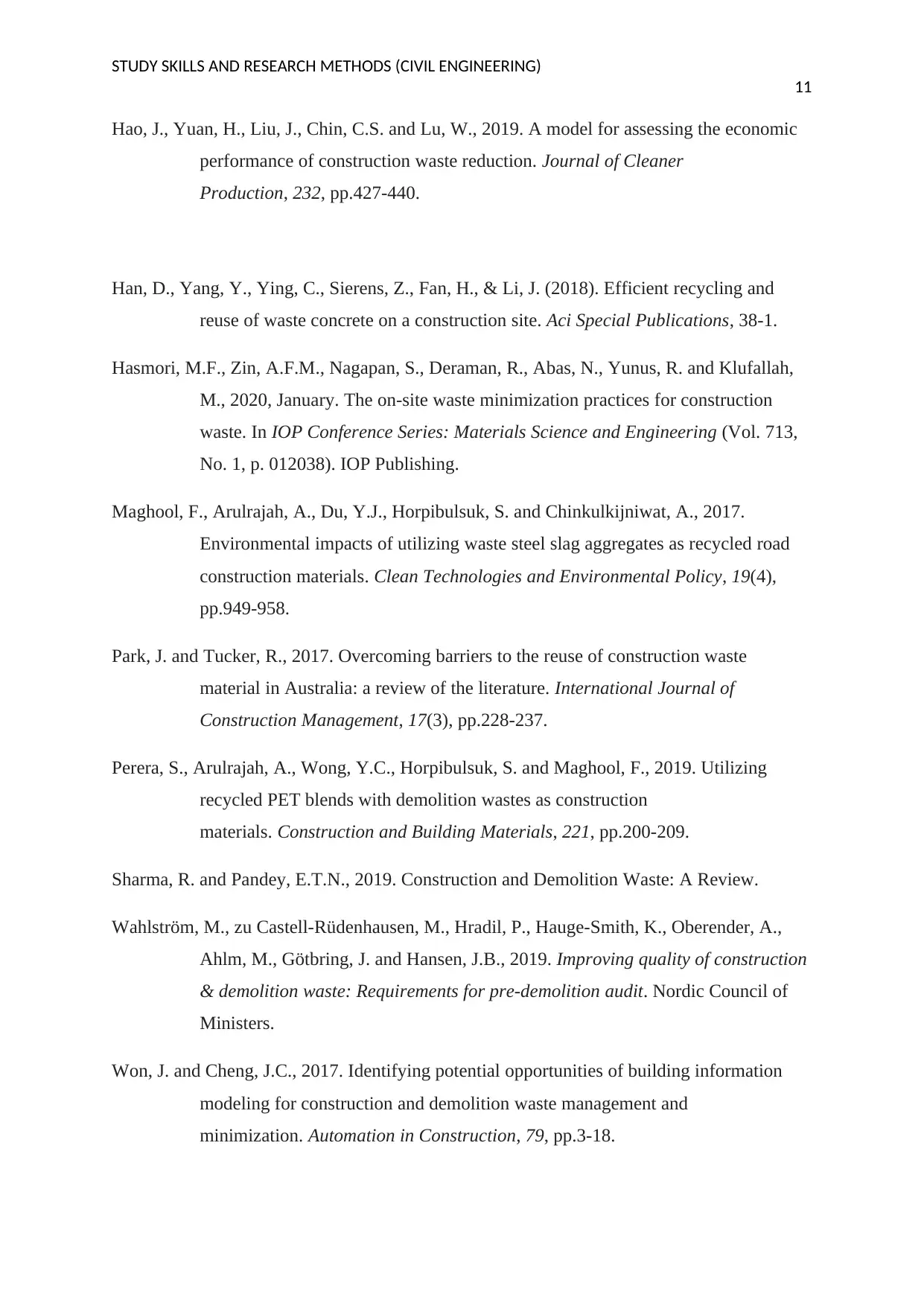
STUDY SKILLS AND RESEARCH METHODS (CIVIL ENGINEERING)
11
Hao, J., Yuan, H., Liu, J., Chin, C.S. and Lu, W., 2019. A model for assessing the economic
performance of construction waste reduction. Journal of Cleaner
Production, 232, pp.427-440.
Han, D., Yang, Y., Ying, C., Sierens, Z., Fan, H., & Li, J. (2018). Efficient recycling and
reuse of waste concrete on a construction site. Aci Special Publications, 38-1.
Hasmori, M.F., Zin, A.F.M., Nagapan, S., Deraman, R., Abas, N., Yunus, R. and Klufallah,
M., 2020, January. The on-site waste minimization practices for construction
waste. In IOP Conference Series: Materials Science and Engineering (Vol. 713,
No. 1, p. 012038). IOP Publishing.
Maghool, F., Arulrajah, A., Du, Y.J., Horpibulsuk, S. and Chinkulkijniwat, A., 2017.
Environmental impacts of utilizing waste steel slag aggregates as recycled road
construction materials. Clean Technologies and Environmental Policy, 19(4),
pp.949-958.
Park, J. and Tucker, R., 2017. Overcoming barriers to the reuse of construction waste
material in Australia: a review of the literature. International Journal of
Construction Management, 17(3), pp.228-237.
Perera, S., Arulrajah, A., Wong, Y.C., Horpibulsuk, S. and Maghool, F., 2019. Utilizing
recycled PET blends with demolition wastes as construction
materials. Construction and Building Materials, 221, pp.200-209.
Sharma, R. and Pandey, E.T.N., 2019. Construction and Demolition Waste: A Review.
Wahlström, M., zu Castell-Rüdenhausen, M., Hradil, P., Hauge-Smith, K., Oberender, A.,
Ahlm, M., Götbring, J. and Hansen, J.B., 2019. Improving quality of construction
& demolition waste: Requirements for pre-demolition audit. Nordic Council of
Ministers.
Won, J. and Cheng, J.C., 2017. Identifying potential opportunities of building information
modeling for construction and demolition waste management and
minimization. Automation in Construction, 79, pp.3-18.
11
Hao, J., Yuan, H., Liu, J., Chin, C.S. and Lu, W., 2019. A model for assessing the economic
performance of construction waste reduction. Journal of Cleaner
Production, 232, pp.427-440.
Han, D., Yang, Y., Ying, C., Sierens, Z., Fan, H., & Li, J. (2018). Efficient recycling and
reuse of waste concrete on a construction site. Aci Special Publications, 38-1.
Hasmori, M.F., Zin, A.F.M., Nagapan, S., Deraman, R., Abas, N., Yunus, R. and Klufallah,
M., 2020, January. The on-site waste minimization practices for construction
waste. In IOP Conference Series: Materials Science and Engineering (Vol. 713,
No. 1, p. 012038). IOP Publishing.
Maghool, F., Arulrajah, A., Du, Y.J., Horpibulsuk, S. and Chinkulkijniwat, A., 2017.
Environmental impacts of utilizing waste steel slag aggregates as recycled road
construction materials. Clean Technologies and Environmental Policy, 19(4),
pp.949-958.
Park, J. and Tucker, R., 2017. Overcoming barriers to the reuse of construction waste
material in Australia: a review of the literature. International Journal of
Construction Management, 17(3), pp.228-237.
Perera, S., Arulrajah, A., Wong, Y.C., Horpibulsuk, S. and Maghool, F., 2019. Utilizing
recycled PET blends with demolition wastes as construction
materials. Construction and Building Materials, 221, pp.200-209.
Sharma, R. and Pandey, E.T.N., 2019. Construction and Demolition Waste: A Review.
Wahlström, M., zu Castell-Rüdenhausen, M., Hradil, P., Hauge-Smith, K., Oberender, A.,
Ahlm, M., Götbring, J. and Hansen, J.B., 2019. Improving quality of construction
& demolition waste: Requirements for pre-demolition audit. Nordic Council of
Ministers.
Won, J. and Cheng, J.C., 2017. Identifying potential opportunities of building information
modeling for construction and demolition waste management and
minimization. Automation in Construction, 79, pp.3-18.
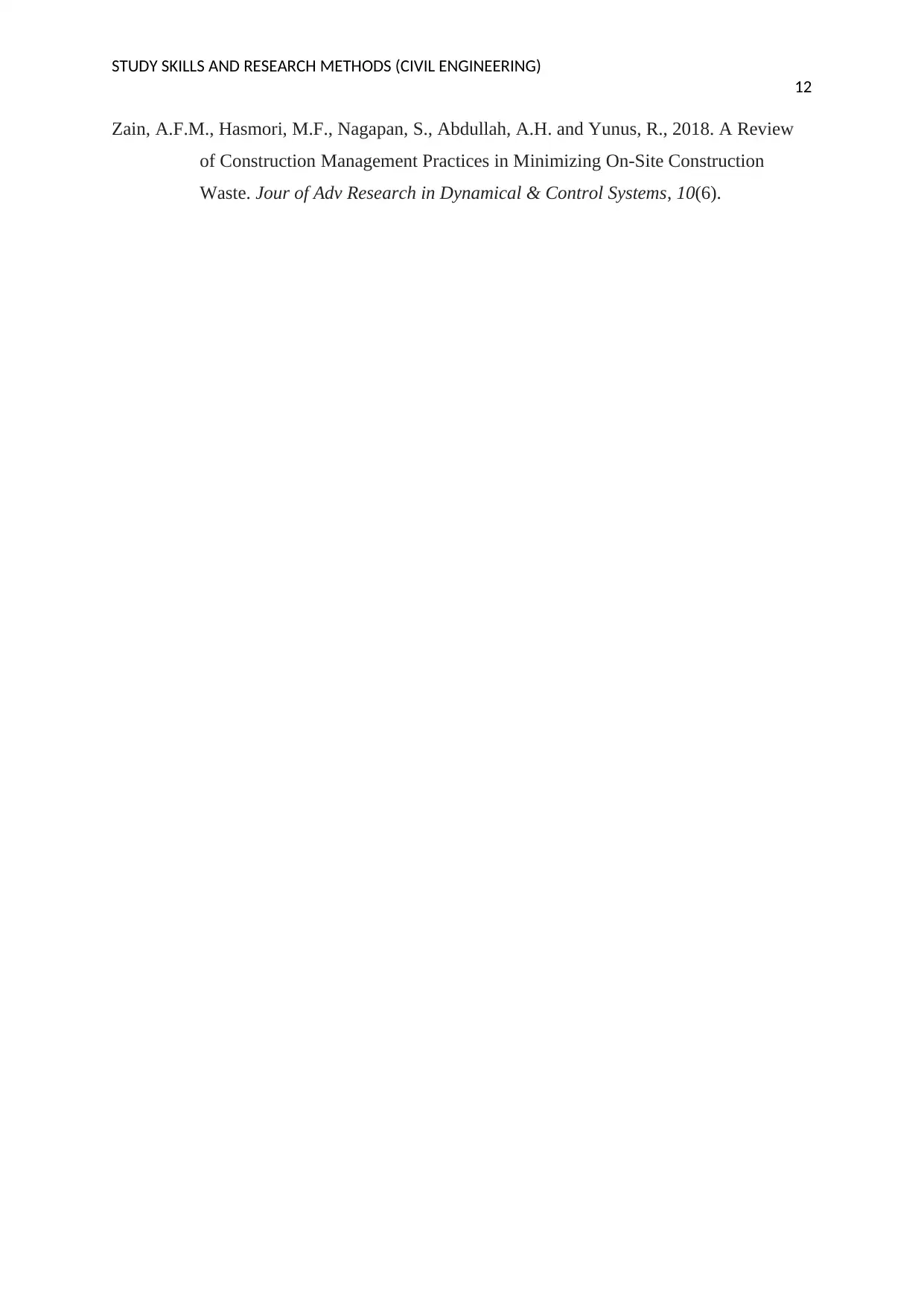
STUDY SKILLS AND RESEARCH METHODS (CIVIL ENGINEERING)
12
Zain, A.F.M., Hasmori, M.F., Nagapan, S., Abdullah, A.H. and Yunus, R., 2018. A Review
of Construction Management Practices in Minimizing On-Site Construction
Waste. Jour of Adv Research in Dynamical & Control Systems, 10(6).
12
Zain, A.F.M., Hasmori, M.F., Nagapan, S., Abdullah, A.H. and Yunus, R., 2018. A Review
of Construction Management Practices in Minimizing On-Site Construction
Waste. Jour of Adv Research in Dynamical & Control Systems, 10(6).
⊘ This is a preview!⊘
Do you want full access?
Subscribe today to unlock all pages.

Trusted by 1+ million students worldwide
1 out of 12
Related Documents
Your All-in-One AI-Powered Toolkit for Academic Success.
+13062052269
info@desklib.com
Available 24*7 on WhatsApp / Email
![[object Object]](/_next/static/media/star-bottom.7253800d.svg)
Unlock your academic potential
Copyright © 2020–2025 A2Z Services. All Rights Reserved. Developed and managed by ZUCOL.





